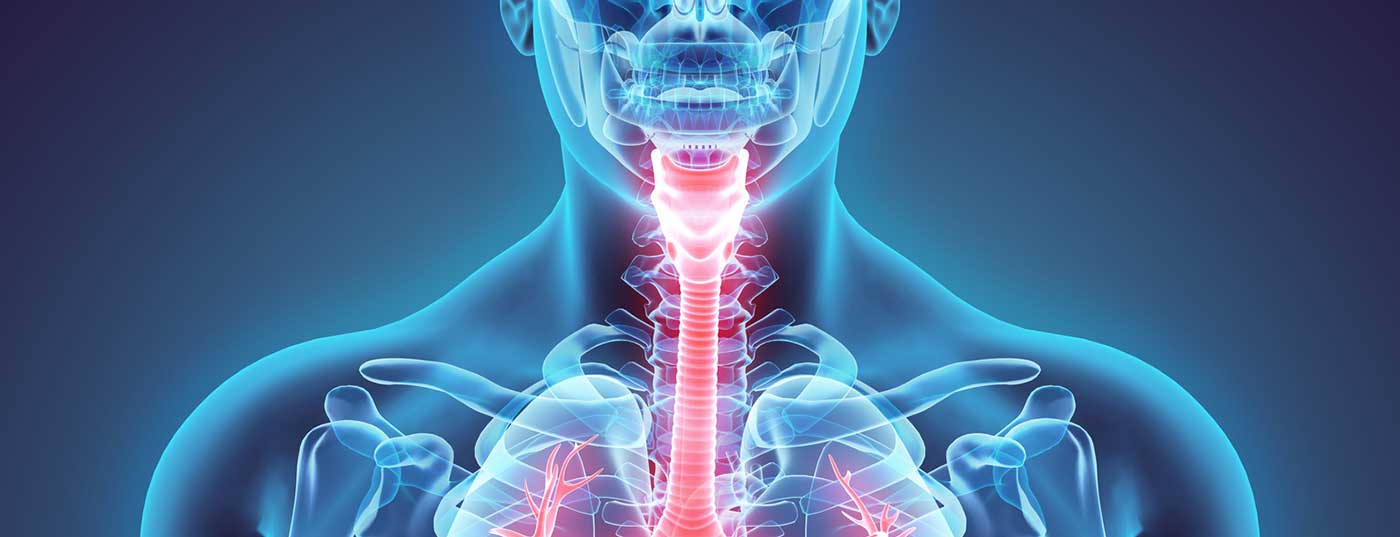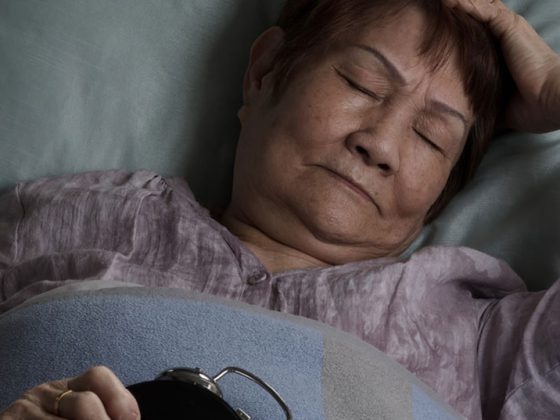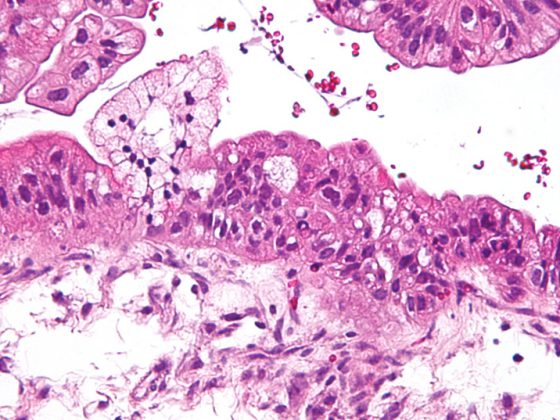A patient suffers from spontaneous, intense to life-threatening shortness of breath, triggered by stress or physical exertion and accompanied by coughing – in everyday life, the diagnosis of bronchial asthma is quickly made here. However, it may also be Vocal Cord Dysfunction. Vocal cord dysfunction is still severely underdiagnosed in practice, with sometimes frustrating consequences for affected individuals.
Vocal cord dysfunction (VCD) is an intermittent, respiratory distress-induced adduction of the vocal cords that occurs very suddenly and usually lasts only a few seconds. However, in those affected, the obstruction may be subjectively perceived as extremely threatening. Careful anamnesis and patient education are therapeutically the first priority. The Schön Klinik in Berchtesgaden is the reference clinic in the German-speaking region for this clinical picture. Several thousand patients have been seen by the team of doctors led by Prof. Dr. Klaus Kenn in recent years.
Prof. Dr. Kenn, only the knowledge and awareness of VCD enables physicians to recognize the problem early and to avoid a possibly wrong and ineffective asthma therapy – which means, conversely, that this clinical picture is still far from being known everywhere?
Prof. Dr. Klaus Kenn: That’s certainly not it. The special thing about the clinical picture is that just having a good medical history – thinking about it and knowing about it – is already the basic prerequisite for recognizing it. The problem is that this is clinically a case of attacking shortness of breath, and if you as a doctor only know one clinical picture for attacking shortness of breath – namely bronchial asthma – it doesn’t even occur to you to consider that it could also be something else.
In addition to limited knowledge, various definitions of terms contribute to the confusion …
Scandinavian otolaryngologists have opposed the term VCD. On the one hand, this is understandable because it is a vague term that only states that the vocal cords are not functioning properly. So not an ideal term. Instead, they came up with the term ILO – inducible laryngeal obstruction. In addition, there is also the variant EILO – the “e” stands for exercised, i.e. load-induced. The problem is that these ENT physicians, because they just don’t see pneumology patients, in my view, are only describing a subset of what VCD actually is. It is not always inducible and it is not only associated with physical stress. These are subgroups, but they do not reflect the complete clinical picture. From this point of view, we should not simply regard these three terms as interchangeable, but classify them correctly.
What can be considered as a trigger for a VCD?
This is very diverse. Overall, it is chemical/physical-irritative stimuli that play a role and can vary greatly from individual to individual. Classic factors are pungent odors, perfume, food fumes, cigarette smoke. Cough not to forget! This is often associated with laryngopharyngeal reflux. So ultimately aspects that can also trigger asthma. Likewise, it may also be physical exertion that leads to a dyspnea-induced picture, which is also easily confused with exertional asthma. Thus, the triggers are diverse, not readily distinguishable from asthma triggers, and therefore generally nondiscriminatory.
The differentiation from the differential diagnosis of bronchial asthma is based on a precise anamnesis. How can one typically describe the course of a VCD attack?
For me, the most important question in the history is: How quickly does the shortness of breath start? Asthma is a seizure-like shortness of breath that can start rapidly. Rapidly, however, in asthmatics usually means between 2 and 5 minutes, during which you notice that each breath is getting heavier and heavier. The VCD, on the other hand, is there from one second to the next. If a patient states that, then it is already a high-level indication that it is more likely VCD. If you then ask whether it’s more inhalation or exhalation that’s affected, that can also lead on because VCD is almost exclusively an inhalation-related dyspnea that’s also accompanied by a stridor sound, whereas asthma is classically an expiratory dyspnea. Also, the question should be asked where the patient feels the obstruction in breathing. An asthmatic patient will indicate in the chest area or behind the sternum, whereas the VCD patient tends to locate the neck area. It is also characteristic that VCD attacks are usually self-limiting. Not always, but usually they end after a few seconds – which feel endless to the patient because they feel like they are suffocating. Mostly, however, it is between 30 and 120 seconds, then the spook is over in its maximum intensity. The asthmatic, on the other hand, must of course be treated. So if I as a physician start to question whether what the patient is telling me really fits with bronchial asthma, then I am already well on the way to being able to classify it diagnostically correctly. And then there doesn’t have to be such often long, frustrating, terrible patient careers where sufferers take asthma medications for years that don’t work in the slightest.
How do you diagnose VCD, what roles do pulmonary function measurements and laryngoscopy play, for example?
Pulmonary function is not certainly discriminatory in that it usually shows concomitant asthma at best, but because of the suddenness and brevity of the VCD attack, one has little opportunity to have a patient in pulmonary function measurement at that time. If you watch the flow-volume curve carefully, you can sometimes see that the inhalation curve, which should be semicircular, already has characteristic “dents” – these may be clues, but not evidence. Laryngoscopy is the gold standard, but even there you can’t always trigger the symptomatology, even if you provoke quite aggressively with irritants. If successful, one has pathologic induced adduction of the vocal cords. It is important to ask the patient whether this was subjectively also his shortness of breath. Because, of course, it is possible to induce laryngospasm during an endoscopy, which has nothing to do with VCD and was just a side effect of the examination.
You advise taking a video via smartphone if possible to document the VCD – in your experience, are pure patient descriptions too non-specific?
A smartphone video is charming in that it is the only way to pinpoint what may be a once-a-month symptom. Such proof is important for patients, otherwise a fatal chain can be triggered because the clinical picture is not detectable and the patient fears that he will not be believed. In general, the patient is central to the history and diagnosis.

If we make a distinction between patients with VCD and patients with VCD and preexisting bronchial asthma – are there strong differences in the course? Does preexisting asthma affect the severity of a VCD attack?
A patient with both will usually classify VCD seizures as much more frightening because they feel more threatening. In reality, however, according to all that is known, they are much more harmless because desaturation never occurs and the fact that they last for a short time means that nothing can happen. However, the subjective feeling of those affected is exactly the opposite. I advise patients with both to pay attention to which respiratory distress is present during an attack – rather the lower, asthma-typical, or the upper, VCD-typical, and to intervene therapeutically accordingly. It can also happen that one seizure triggers the other, in which case all therapeutic means must ultimately be pulled.
Today, physical symptoms such as reflux are assumed to be the main cause of VCD. How do you assess the possibility of psychological causes?
There probably is, although that is more of a clinical observation, not a proof. I consider VCD to be predominantly a somatopsychic condition in which physical problems entail psychological problems because they are not resolved and remain threatening. But there are certainly extremely anxious people who react with a VCD when stressed.
What does the therapy look like?
There is no drug therapy. Non-drug therapy consists first of all of teaching the patient what he or she is probably or definitely suffering from. By then understanding what triggers the dyspnea, what can be called “de-scaring” occurs. When the fear is gone, the door to therapy is already open. Then the patient only has to learn to self-regulate how to experience as little respiratory distress as possible during an attack, or to get out of it as quickly as possible, through breathing strategies and modifications of breathing. The patient will have a throat stressed breathing during a VCD attack. The more he fights it, the worse he makes it, because the breathing effort in the throat area leads to the narrowing of the airways. He has to learn to do almost nothing during an attack, just breathe calmly through his nose. The next step after understanding is then experiencing, that is, that what he has been taught ideally works. Then he has an “aha” moment that enables him to deal with such situations in the future.
The interview was conducted by Jens Dehn
Literature:
- Koczulla AR, Kenn K: Dtsch Arztebl 2018; 115(24): 16-20; doi: 10.3238/PersPneumo.2018.06.15.004.
InFo PNEUMOLOGY & ALLERGOLOGY 2020; 2(3): 26-27.











